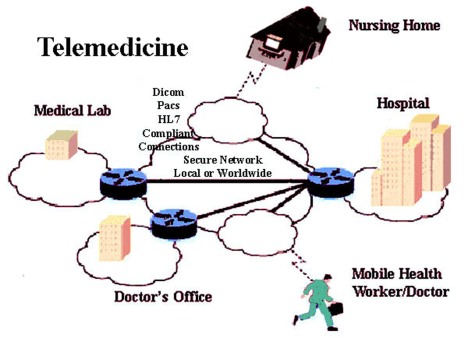
According to the American Telemedicine Organization, telemedicine is the use of electronic c

According to the American Telemedicine Organization, telemedicine is the use of electronic communications and information technologies to provide clinical services when participants are at different locations. Closely associated with telemedicine is the term telehealth. This term is often used to encompass a broader application of technologies to distance education, consumer outreach, and other applications wherein electronic communications and information technologies are used to support healthcare services. Videoconferencing, transmission of still images, e-health including patient portals, remote monitoring of vital signs, continuing medical education and nursing call centers are all considered part of telemedicine and telehealth.
The delivery of remote health services is used for a variety of purposes:
- Direct patient care such as sharing audio, video and medical data between a patient and a health professional for use in rendering a diagnosis, treatment plan, prescription or advice. This might involve patients located at a remote clinic, a physician’s office or home.
- Remote patient monitoring uses devices to remotely collect and send data to a monitoring station for interpretation. Such “home telehealth” applications might include using telemetry devices to capture a specific vital sign, such as blood pressure, glucose, ECG or weight. Such services can be used to supplement the use of visiting nurses.
- Specialist referral services typically involve a specialist assisting a general practitioner in rendering a diagnosis. This may involve a patient “seeing” a specialist over a live, remote consult or the transmission of diagnostic images and/or video along with patient data to a specialist for viewing later.
- Medical education and mentoring, which range from the provision of continuing medical education credits for health professionals and special medical education seminars for targeted groups to interactive expert advice provided to another professional performing medical procedure.
- Consumer medical and health information includes the use of the Internet for consumers to obtain specialized health information and on-line discussion groups to provide peer-to-peer support.
Remote health care relies on several means for the delivery of data:
- Networked programs link tertiary care hospitals and clinics with outlying clinics and community health centers in rural or suburban areas through either hub-and-spoke or integrated networked systems. The links may use dedicated high-speed lines or the Internet for telecommunication links between sites. It is estimated that there are about 200 telemedicine networks in the United States involving close to 3,500 medical and healthcare institutions throughout the country.
- Point-to-point connections using private networks are used by hospitals and clinics that deliver services directly or contract out (out sourced) specialty services to independent medical service providers at ambulatory care sites.
- Health provider to the home connections involves connecting primary care providers, specialists and home health nurses with patients over single line phone-video systems for interactive clinical consultations. Such services can also be extended to a residential care center such as nursing homes or assisted living facility.
- Direct patient to monitoring center links are used for pacemaker, cardiac, pulmonary or fetal monitoring and related services and provide patients the ability to maintain independent lifestyles.
- Web-based e-health patient service sites provide direct consumer outreach and services over the Internet.
With the looming physician shortage, this technology delivers much needed access for small and rural healthcare providers. CMS has taken notice and developed a new credentialing and privileging process for practitioners delivering healthcare services remotely. In the presence of faster and more reliable networks, wireless devices, high-definition digital images and video, telehealth could be the fulcrum for this long overdue multi-pronged approach.